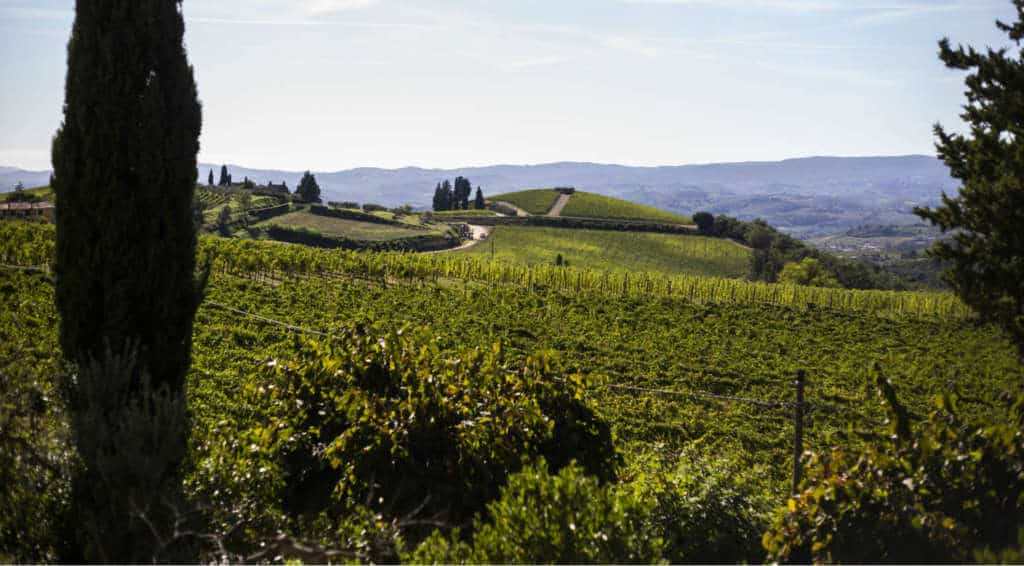About Castello di Monsanto
In 1961, newlyweds Fabrizio and Giuliana Bianchi were bequeathed a little-known estate in the Chianti Classico region of Tuscany. Possibly one of the most magical wedding gifts ever, Castello di Monsanto continues to exert a romantic allure, but added to that has since gone on to acquire a worldwide reputation for its outstanding collection of undeniably Tuscan wines. Five decades have passed since the Bianchi family acquired Castello di Monsanto. Yet, in an age of winemaking marked by dramatic shifts and stylistic change, the Bianchis have remained singularly consistent in their dedication to crafting wines that remain faithful to their origins.
“Our goal is to make wines of integrity and personality that are true to their terroir. And if this means that we have had to back away from certain technological advances and remain firm in the face of pressure to make wines of the moment, it’s a risk my family and I have been more than willing to take.”
– Laura Bianchi, family proprietor, Castello di Monsanto
Despite a deep-rooted attachment to the traditions and integrity of Chianti Classico wines, the Bianchis are hardly captives of the past. Under their leadership, this historic property between Florence and Siena, comprising an 18th-century villa and 568-acres of land, of which 178 acres are planted to vine, has pushed the boundaries on multiple fronts. These include:
– Becoming the first estate to bottle a single-vineyard Chianti Classico, in 1962. Fifty years on, many leading wine authorities view the Monsanto Il Poggio Chianti Classico Riserva from the 13-acre vineyard of the same name among the finest red wines in the world.
– Starting 1968, in a quality-oriented move, becoming one of the first Chianti Classico properties to omit white grapes from the traditional Chianti Classico blend
– The introduction of de-stemming in 1968, along with abandonment of the traditional Governo alla Toscana technique by which re-fermentation is induced through the addition of later-harvest grapes
– Becoming the first Chianti Classico estates, in 1968, to bottle a 100% Sangiovese.
– Planting Cabernet Sauvignon in the 17-acre Il Mulino vineyard, which due to frost had frequently proved inhospitable to earlier-budding Sangiovese. Today, this now old-vines Sangio-vizza (a local expression denoting a Cabernet headed in the elegant and refreshing direction of Sangiovese) is sold under the Nemo IGT.
– Substituting chestnut with Slavonian oak barrels over the course of the 1970s, to create sweeter, less aggressive tannins.
– The pioneering introduction in 1996 of truncated cone-shaped, rather than the traditional cylindrical-shaped fermentation vats, to enhance extraction during maceration
2000 was the last vintage made entirely by Fabrizio Bianchi, but transition to the next generation was seamless as his daughter, Laura, had started her apprenticeship with her father over a decade earlier. Since 2000, winemaking responsibilities have been handled by Laura, working closely with Andrea Giovanni, previously winemaker at Ornellaia, who joined Monsanto in 2001. From childhood Laura has made a point of spending significant amounts of time with vineyard staff and their families, many of whom have worked at Castello di Monsanto for decades or over several generations. As a result, she has acquired a profound understanding of the special qualities and unique terroirs of the estate she has inherited and calls home. Consequently Laura is no great fan of consulting winemakers, who she considers are unable to draw upon the collective fund of accumulated memories, insights and site-specific knowledge brought to the table by the “old timers.”
Both father and daughter share the belief that the quality of a wine depends largely on the quality of the fruit. That means Lotta Integrata — almost organic farming using only sulfur and copper to bring out the best in their special terroir.
The Monsanto estate is blessed with pure Galestro soil, especially friable at the top, enabling vineroots to go down deep, while the compact sub-layer holds water even in very dry years. On galestro, sangiovese grapes grow reacher in acidity and structure, giving the wines great agability. All around Monsanto, a “green lung” of cypress and oak forest helps produce the enzymes that “flavor” the vineyard. Grapes are 90% water and the small streams that encircle Castello di Monsanto not only bring life to the soil, but protect the grapes during drought years. Another exceptional feature is the circulating air of the Valdelsa exposed natural amphitheater, with everlasting cooling breezes that enable a long, gentle growing season and keep the vines healthier.
Today the Castello di Monsanto portfolio includes:
– Fabrizio Bianchi Chardonnay ,a single vineyard elegant and full of minerality white
– Fabrizio Bianchi Rosato made with Sangiovese from youngest vines
– Monrosso DOCG Chianti, our youngest wine produced from vines just outside the Chianti Classico appellation
– Chianti Classico, which shows a surprising combination of power and elegance
– Chianti Classico Riserva DOCG, known worldwide as one of the finest examples of Chianti Classico
– Il Poggio Chianti Classico Riserva DOCG, an iconic, world-class traditional Tuscan red from a single vineyard
– Nemo IGT, a single-vineyard Cabernet Sauvignon created far ahead of its time from 40+ year-old vines
– Fabrizio Bianchi Sangiovese from the old Scanni Vineyard
– Vin Santo La Chimera IGT, a luscious dessert wine aged 12 years before release
Of special pride is the Bianchi family’s collection of old vintages, one of largest collections of award-winning “library wines” in Italy stretching back more than 50 years.
This beautiful property, with its gardens still lovingly tended by Laura’s mother, Giuliana, is open for tours year-around. A highlight for visitors is the property’s cellar, a marlstone tunnel just shy of 1,000 feet, excavated by hand in the 1980s using medieval construction techniques.



Our goal is to make wines of integrity and personality that are true to their terroir.